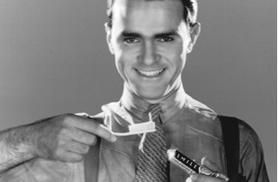The guy in the 1940's toothpaste ad has a toothbrush that looks two inches long, and he is covering every bit of it. That is what you see in most ads, the entire brush covered in paste. But how much do you really need? Or do you really need it at all?
The consensus appears to be that nobody needs any more than a blob the size of a pea. Period. It also appears that the only reason to use the stuff is to deliver flouride; if you get flouride from other sources then it probably isn't necessary at all. This writer's hygenist suggests that I clean the top of my teeth with a dry toothbrush with no toothpaste; Others note older people "can brush more easily and more effectively using a wet brush only. This allows you to see the gum line better and identify any areas that might need more attention (areas that bleed)."
Advertisement
There are specialty toothpastes for whitening, for tartar control and for sensitivity (by adding sodium nitrate, or Saltpetre. Given the urban legend that saltpetre was added to food in the army to curb sex drives, it probably isn't the best thing to be putting in your mouth). Neither is sodium laurel sulphate, a surfactant that dries skin and causes irritation, or triclosan, a gender-bender bactericide that shouldn't be anywhere near our mouths.
So, in summary,
1)the "right amount" of toothpaste is the size of a pea.
2)even if you want the benefits of whiteners and flouride, it probably isn't necessary to use it more than once a day.
3) It is probably better to use all-natural products from the health food section, and to follow our rule: If you can't pronounce an ingredient, you probably don't want it in your mouth.
Other posts on How Much is Enough?
Don't Change Your Motor Oil More Than You Have To
Advertisement
